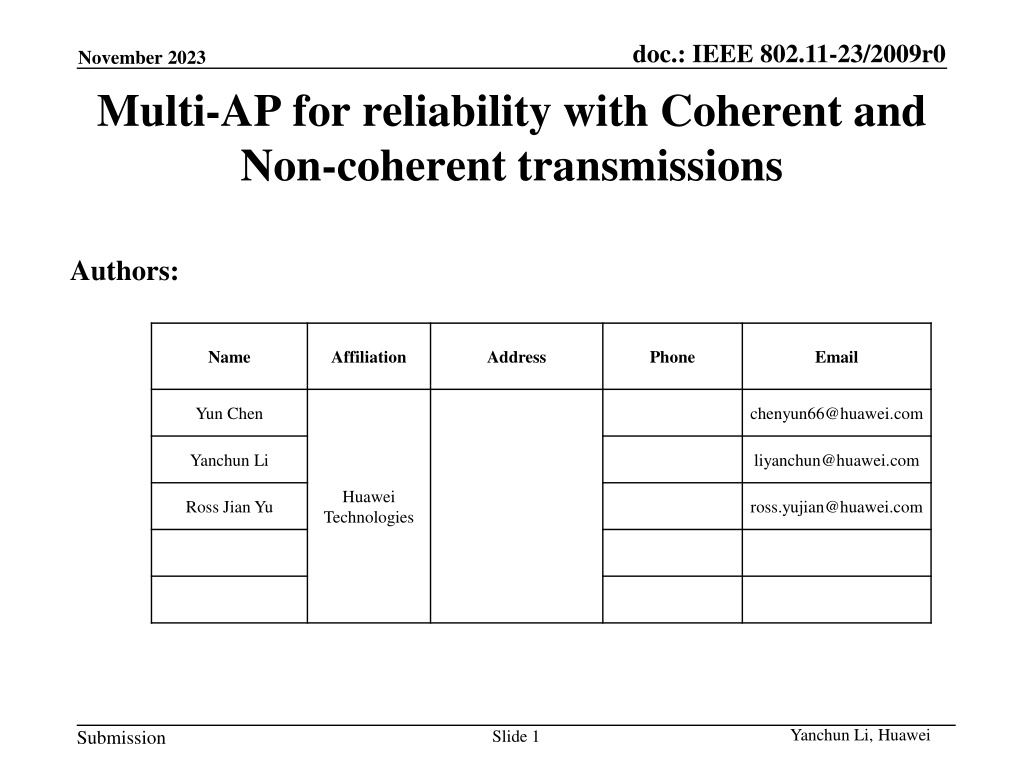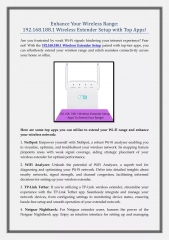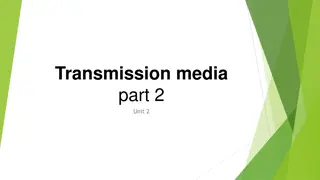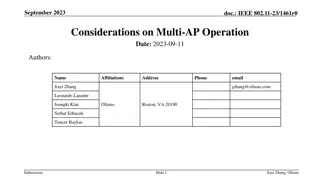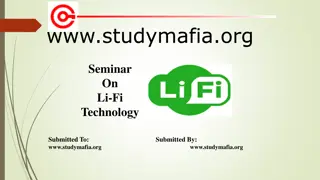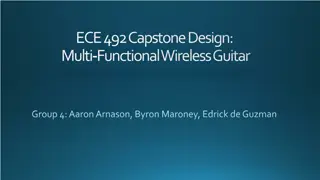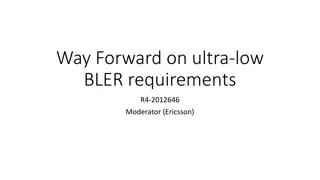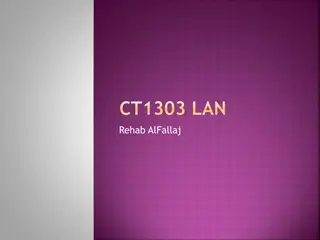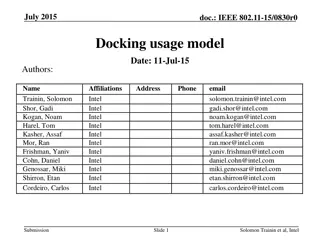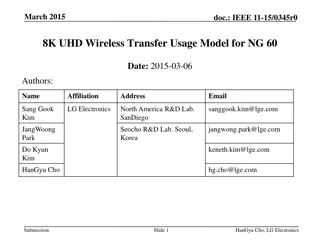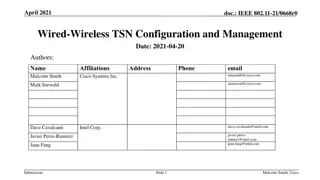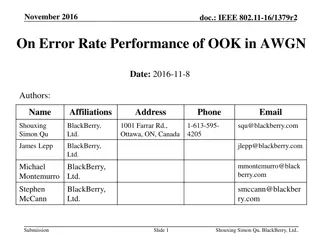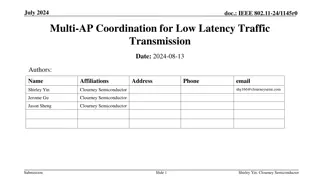Multi-AP for Reliable Wireless Transmission with Coherent and Non-coherent Technology
In this IEEE 802.11-23/2009r0 document, the concept of Multi-AP coordination is discussed to achieve Ultra High-reliability (UHR) goals. The use of both Coherent Joint Transmission (JT) and Non-coherent transmission technologies is explored for improved reliability and performance in wireless communication scenarios. Various scenarios and principles related to these technologies are presented, emphasizing the benefits of Joint Transmission in enhancing throughput and reducing interference among multiple access points and stations. Coherent and Non-coherent transmission modes are compared in terms of their diversity gains and effectiveness in challenging signal conditions.
Download Presentation

Please find below an Image/Link to download the presentation.
The content on the website is provided AS IS for your information and personal use only. It may not be sold, licensed, or shared on other websites without obtaining consent from the author. Download presentation by click this link. If you encounter any issues during the download, it is possible that the publisher has removed the file from their server.
E N D
Presentation Transcript
doc.: IEEE 802.11-23/2009r0 November 2023 Multi-AP for reliability with Coherent and Non-coherent transmissions Authors: Name Affiliation Address Phone Email Yun Chen chenyun66@huawei.com Yanchun Li liyanchun@huawei.com Huawei Technologies Ross Jian Yu ross.yujian@huawei.com Yanchun Li, Huawei Slide 1 Submission
doc.: IEEE 802.11-23/2009r0 November 2023 Introduction Multi-AP coordination was proposed in several contributions to meet UHR goals defined in PAR. Joint transmission (JT) has been extensively discussed as a candidate technology of MAP due to its high gains. Grouping together multiple APs as a virtue big AP with large number of antennas and high degrees of freedom to provide substantial gains. Presentations so far have mainly focused on Coherent JT In this contribution, we introduce the principle of Non-Coherent JT Yanchun Li, Huawei Slide 2 Submission
doc.: IEEE 802.11-23/2009r0 November 2023 Coherent Joint Transmission Principle A virtual big AP constituting of multiple APs with large number of antennas and high degrees of freedom to perform beamforming to improve the throughput and to reduce inter-STA interference. System transmission model Suppose 2 APs each with 2 antennas performance JT to transmit 2 data streams to 2 single-antenna STAs The received signal y can be written as follow: Main-AP Virtual big AP AP #2 AP #K AP #1 ?11 ?21 ?31 ?31 ?12 ?22 ?32 ?42 STA #1 STA #2 ?? ?? ?? ?? ?? ?? ?11 ?21 ?12 ?22 ?13 ?23 ?14 ?24 ? = = + = ??? + ? ???2 ???1 where H is the channel, F denotes the precoder, and n is the noise. Yanchun Li, Huawei Slide 3 Submission
doc.: IEEE 802.11-23/2009r0 Sep. 2023 Coherent Joint Transmission Scenarios The following possible scenarios were discussed in [1] Scenario #1 Scenario #2 AP2 AP2 Data frame at T2 at T1 at T2 AP1 AP1 STA STA AP3 Both scenarios have one Main AP (AP1) acting as the AP coordinator which can be heard by all other SAPs ( Secondary APs ) CSI and data sharing at time T1 Joint transmission at time T2 Yanchun Li, Huawei Slide 4 Submission
doc.: IEEE 802.11-23/2009r0 November 2023 Non-coherent transmission(1)-- Diversity Mode ?2 ?1 Diversity SAP2 SAP1 Received signal [?AP1*?1+?AP2 ?2] ? + ? 1) Multiplexing gain + Diversity gain+ power gain Gian From 2) Increasing the number of multiple-path; 3) Probability of signal cancellation Scenarios Low SINR/RSSI Yanchun Li, Huawei Slide 5 Submission
doc.: IEEE 802.11-23/2009r0 November 2023 Non-coherent transmission(2)-- Multiplexing mode Multiplexing ?2 ?1 SAP2 SAP1 Received signal [???1*?1 ?1 + ???2 ?2 ?2 + ?] 1) Multiplexing gain+ Diversity gain+ power gain Gian From 2) Increasing the number of multiple-path 3) Probability of interferences between layers 1) Channel medium or low correlation Scenarios 2) Low RSSI difference between SAPs Yanchun Li, Huawei Slide 6 Submission
doc.: IEEE 802.11-23/2009r0 November 2023 Coherent Joint Transmission Protocol Adapted from [1] JTA frame backhaul transmission Identifying secondary APs participating in joint transmission Joint Sounding between SAPs Data frame backhaul transmission Data sharing to all SAPs Joint Transmission Trigger frame announces the joint transmission Synch. among SAPs Estimate CFO, SFO Joint transmission by SAPs to STAs STA2 Primary -AP Secondary -AP1 S-AP2 STA1 JTA frame All Data frame All Data frame JT Trigger frame Data frame using joint transmission Yanchun Li, Huawei Slide 7 Submission
doc.: IEEE 802.11-23/2009r0 November 2023 Non-Coherent Joint Transmission Protocol STA2 Duplicate Multi-Point JTA frame backhaul transmission Identifying secondary APs participating in joint transmission Data frame backhaul transmission Data sharing to all SAPs No need Joint-sounding and CSI sharing No need strict Synch. among SAPs STA can handle SAP s residual CFO 11ax-midambles can be used in the jointly steered packet to offset the impact of residual CFO [2] Primary -AP Secondary- AP1 S-AP2 STA1 JTA frame All Data frame All Data frame JT Trigger frame Data frame using joint transmission Yanchun Li, Huawei Slide 8 Submission
doc.: IEEE 802.11-23/2009r0 November 2023 Non-Coherent Joint Transmission Protocol Symmetry Multi-Point JTA frame backhaul transmission Identifying secondary APs participating in joint transmission No need Joint-sounding and CSI sharing No need data sharing between SAPs No need strict Synch. among SAPs STA2 Primary -AP Secondary- AP1 S-AP2 STA1 JTA frame Data frame Layer1 Data frame Layer2 JT Trigger frame Data frame using joint transmission Yanchun Li, Huawei Slide 9 Submission
doc.: IEEE 802.11-23/2009r0 November 2023 Comparison among various JT schemes Coherent Joint Transmission Non-Coherent Joint Transmission Multiplexing-mode Non-Coherent Joint Transmission Diversity-mode Primary -AP Primary -AP Without data sharing: - Bit stream 1 and 2 can contain separate MPDUs; Primary -AP Copies of Bit stream Bit stream2 Bit stream1 Copies of Bit stream Or, with data sharing: - Split bits from same PPDU into two bit streams S-AP1 S-AP2 S-AP2 S-AP1 ?? Secondary- AP1 S-AP2 ?11 0 0 ?? ?? ? = ?11 ?12 + ?? ??+ ?? ?? ?11 0 0 ???jf? ?22?j? ? ?12??? ? ? = ?11 ?22 ?? ?? ?? ?? ?11 ?21 ?12 ?22 ? = ?11 ?12 + Use CSD or STBC to construct non-coherent waveform ?11,?12 ?r ?? ?11,?12,?21,?22 ?? ?? Joint- sounding CSI sharing Data sharing Synchronization Coherent JT Y Y Y High (Phase-level) Diversity Mode N N Y Low (Symbol-level) Multiplexing Mode N N Optional Low (Symbol-level) Yanchun Li, Huawei Slide 10 Submission
doc.: IEEE 802.11-23/2009r0 November 2023 Coherent vs Non-Coherent JT In the low fronthaul capacity regime, only a limited number of STAs can be supported by the coherent JT[1] Channel bandwidth B = 20 MHz, the number of transmit antennas of M = 2, 14 APs, 10 STAs Yanchun Li, Huawei Slide 11 Submission
doc.: IEEE 802.11-23/2009r0 November 2023 Conclusions In this contribution, we introduced the principle of coherent/non-coherent Joint Transmission We consider that Joint Transmission is crucial for UHR reliable transmissions. Non-coherent JT has lower requirement in implementation non-coherent Joint Transmission has less information sharing requirement non-coherent Joint Transmission has no need strict Synch. among SAPs We would like to see if people are interested at this candidate JT option for 11bn. Yanchun Li, Huawei Slide 12 Submission
doc.: IEEE 802.11-23/2009r0 November 2023 Straw Poll Are you interested in NC-JT for 11bn Yes No Need more information Yanchun Li, Huawei Slide 13 Submission
doc.: IEEE 802.11-23/2009r0 November 2023 Reference [1] C. Pan, H. Ren, M. Elkashlan, A. Nallanathan and L. Hanzo, "The Non- Coherent Ultra-Dense C-RAN Is Capable of Outperforming Its Coherent Counterpart at a Limited Fronthaul Capacity," in IEEE Journal on Selected Areas in Communications, vol. 36, no. 11, pp. 2549-2560, Nov. 2018, doi: 10.1109/JSAC.2018.2874138. [2] https://mentor.ieee.org/802.11/dcn/19/11-19-1094-00-00be-joint-bf- simulations.pptx Yanchun Li, Huawei Slide 14 Submission
doc.: IEEE 802.11-23/2009r0 November 2023 Appendix: Non-Coherent Joint Transmission (Multiplexing Mode) vs. Co-BF Non-Coherent Joint Transmission Multiplexing Mode Co-BF Primary-AP Primary-AP (e.g. reuse multi-RU interleaver) STA1 s Bit stream1 STA1 s Bit stream2 STA2 s Bit stream STA1 s Bit stream Secondary- AP1 S-AP1 Secondary -AP2 S-AP2 ?? ??+ ?? ?? ?? ??+ ?? ?? ?11 0 0 ?11 0 0 ?12??? ? ?12??? ? ? = ?11 ? = ?11 ?22 ?22 STA1 STA1 STA2 ?? and ?? are both for STA1 ?? and ?? are for STA1 and STA2, respectively. Small difference Yanchun Li, Huawei Slide 15 Submission
doc.: IEEE 802.11-23/2009r0 November 2023 Appendix: Complexity Analysis SU MIMO Non-Coherent Joint Transmission Multiplexing-mode UL MU MIMO M-AP (e.g. reuse multi-RU interleaver) Bit stream2 Bit stream1 S-AP1 S-AP2 ?? ??+ ?? ?? ?11 0 0 ?12??? ? ? = ?11 ?22 STA receives multi-spatial stream PPDU. STA perform per-AP phase tracking. STA receives multi-spatial stream PPDU. STA perform single-AP phase tracking. STA receives multi-spatial stream PPDU. STA perform per-AP phase tracking. STA does not need to run scheduling algorithm and has low complexity STA does not need to run scheduling algorithm and has low complexity AP needs to run scheduling algorithm and has low complexity Similar to SU MIMO Rx Yanchun Li, Huawei Slide 16 Submission
